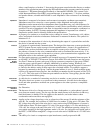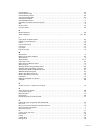
Glossary149
T
Talent
Collective name for all performers and actors who appear regularly on television.
Talk Level 1
Talk level 1 is the normal talk key assignment. This is the assignment that normally appears in the
alphanumeric display (on keypanels so equipped). You may add a talk level 2 assignment to
activate a second device along with talk level 1.
Talk Level 2
Talk level 2 is used with stacked talk keys. A stacked talk key activates two types of
communication at once. For example: a stacked talk key could simultaneously activate audio
output to a transmitter and key the transmitter using a relay. The audio output is called the level l
assignment and the relay is called the level 2 assignment.
Tally
An intercom’s tally usually identifies a calling party to a called party, tally can also indicate a call
waiting.
Telco
Abbreviation for Telephone Company. Refers to communication lines owned and operated as part
of a standard telephone system.
Tone Signaling
An audio tone distributed on the intercom line (may be associated with light signaling). This tone
is often used for alerting an operator.
Transducer
In sound, a device that converts acoustic energy to electrical (e.g.: microphone) or vice versa
(e.g.: loudspeaker).
Transformer
Audio transformer: a device that can isolate two circuits, and, in addition, match impedances, step
up or down voltages or currents. A microphone transformer can be used to optimize the signal to
noise ratio of a microphone preamplifier combination. Power transformer: a device that isolates
electronic circuitry from a direct connection with the power line, and provides power at a
convenient voltage for the electronic equipment (usually rectified and filtered first).
Transient
In acoustics, a sudden change such as that from a percussive instrument (drum or piano). In
electronics, a sudden change such as a stepped signal or spiked signal.
Transient
Intermodulation
Distortion
See Distortion.
Transient
Response
Equipment needs to be designed to be damage proof from power line transients. Good audio
equipment needs to handle well signal transients that occur normally. Transient handling may
require headrooms of 20 to 60 decibels. The headphone amplifiers used in RTS™ Systems
intercoms generally have good transient handling capability.
Trunking
Trunking is a method of interconnecting two or more independent intercom systems. The
connection is accomplished by reserving one or more audio ports in each of the intercom systems
for use as audio links between the systems. A special device, called a Trunking Master Controller,
is required to control access and usage for the trunked intercom ports. A configuration utility,
called CStrunk, is used to set up the Trunking Master Controller.
Two-Wire
A communications system where the path is the same for both talk and listen. In electrical
pathways there are, in fact, two wires (one path). Two-wire systems can be two- wire balanced or
two-wire unbalanced.
Two-Wire
Balanced
Two-wire balanced is similar to two wire unbalanced except that neither conductor is tied to
circuit common. Circuit common is either tied to a transformer center tap, or is an electrical center
point, or not tied at all.
Two-Wire
Unbalanced
A two-wire system that uses a circuit common and one additional conductor for a pathway. This
system allows easy addition of DC power as well. Although a balanced two wire system has less
sensitivity to outside electrical interference.
Unbalanced
Line
A communications line that uses circuit common or “ground” as a return path. In the case of
intercom systems, in general, an unbalanced line is more susceptible to noise interference. But
practically speaking, a low impedance unbalanced line (200 ohms) works well in the real world,
and has the added advantage of being able to operate on just two wires, carrying the DC power,
the full duplex audio signal, the 20.000 kilohertz call light signal, and the 24.000 kilohertz
microphone reset signal. Many installations have been previously wired for telephone operation
and the two wire intercom works on these pairs. A special “golf’ system application of the TW
System has the advantages of the TW system and balanced line operation. A standard TW power


















